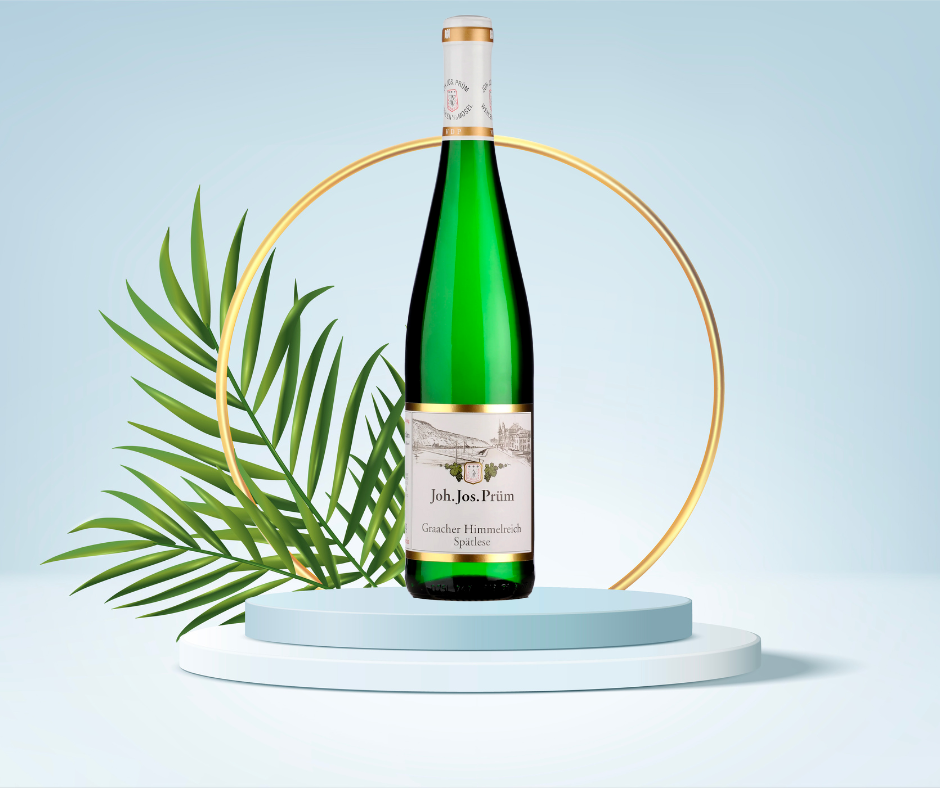
Let’s dive into Joh. Jos. Prüm Graacher Himmelreich Riesling Spätlese (Spätlese means late harvest). Oftentimes, when choosing a wine, versatility is at the top of my list. While I like to have specific wines for specific occasions – whether it’s a pairing menu, or a seasonal favorite for patio or poolside gatherings, having a wine on hand that fits in to a multitude of scenarios is always a win. If you’re looking for a great white, Joh. Jos. Prüm Riesling is an excellent choice.
The Joh. Jos. Prüm Graacher Himmelreich Riesling Spätlese Guide
J. J. Prüm Graacher Himmelreich Riesling Spätlese Overview
This Riesling is pale in color, and known for its vibrant acidity, fruitiness, and floral aromas. This will age well due to the higher acidity. You’ll detect notes of pear, apple and apricot, with notes of honey, and a hint of minerality. This one is definitely sweet! Fresh and crisp.
Average Price
In my opinion, what sets this one apart from some others is the producer. They typically pick their grapes later than most, so the wines tend to be on the sweeter side. There is definitely some acidity here, so this will age well. Dave did a horizontal tasting a month ago with their 2005 vintage and found them all to be excellent, and still fresh. 2005 is considered one of their best vintages!
This would pair well with meats like pork and poultry, as well as shellfish and spicy dishes. If you’re not looking for a full on dinner, it also works well with cured meats – or even as a dessert wine (with or without the actual dessert).
ALCOHOL %
8%
COUNTRY
Germany
REGION
Mosel/Graach
STYLE
Sweet
BODY
Medium
What Does this Spätlese Taste Like? (Tasting Notes)
This white is known for its fresh acidity, as well as crisp and sweet fruity flavor profile. Here are the typical tasting notes you can expect from this wine:
ON THE NOSE
Aromas of ripe stone fruits, such as peach and apricot, as well as citrus notes like lemon and lime.
ON THE PALATE
Flavors of pear, apple and peach, and a touch of honey, and minerality. Sweet with sharp acidity.
Overall it has a crisp and refreshing acidity that’s balanced by sweetness, which makes it easy to drink and perfect for any occasion – especially if you enjoy a sweeter Riesling. While Riesling is a great wine to add to your summer sips, we enjoy it all year round, as it pairs well with holiday desserts, or with friends any time.
Pros & Cons
It goes without saying that everyone’s preference and pallet is different. And we always say, just drink what you like. But we’ve made a few points below that we thought were worth noting, based on our personal experience. And since Riesling is one of Dave’s favorites, I’ve had quite a few placed in front of me. As luck would have it, what I enjoy is more or less the complete opposite of what he enjoys, so you’re really getting both sides of the coin here.
WHAT I LOVED:
- Pleasant, easy to drink and fruity a light, refreshing taste.
- Seems to age well. So drink now, or drink later – whatever works for you!
- Versatile, though for me personally the sweetness pairs well fruit based desserts.
JUST A HEADS-UP
- Some may find this one a little too sweet, present company included. So while I am always open to trying sweeter wines, this is really more of a “one glass” for me. Though Dave, who prefers sweeter wines loves this one.
What is the difference between Spätlese and Kabinett?
Spätlese and Kabinett are two different classifications of German Riesling wines based on their level of ripeness and sugar content. Here are the main differences between Spätlese and Kabinett:
Ripeness level: Spätlese is made from grapes that are harvested later than Kabinett grapes, so they are riper and have a higher sugar content.
Sugar content: As a result of their higher ripeness level, Spätlese wines have a higher sugar content than Kabinett wines. But if your bottle or label says Trocken, that usually indicates that it is a dryer expression with higher alcohol.
Style: Spätlese wines are generally fuller-bodied, richer, and more complex than Kabinett wines. They often have a more intense fruit flavor, along with a nice balance of sweetness and acidity. Kabinett wines, on the other hand, are generally lighter-bodied and tend to be a bit more crisp and refreshing.
Food pairings: Due to their higher sugar content, Spätlese wines often pair well with spicy or savory dishes, such as Asian cuisine or pork with fruit sauces. Kabinett wines, with their lighter style, may be better suited for lighter fare, such as salads or seafood.
Overall, Spätlese (meaning late harvest) wines are generally considered to be a step up in quality and complexity from Kabinett wines, and are typically more expensive as a result. However, both styles are enjoyable and offer their own unique characteristics.
Where to Buy It Online
J. J. Prüm Graacher Himmelreich Riesling Spätlese

Conclusion
Overall, I enjoy J. J. Prüm Graacher Himmelreich Riesling Spätlese. While it’s on the sweeter side and I generally prefer drier, I still find this an enjoyable, easy to drink wine that ages well. It comes with a price tag that is a bit on the higher side, so that’s always something to keep in mind. You almost can’t go wrong with this producers, and if you like to do various vintages from the same producer, this was a fun one to do.
Reader Comments (How Our Readers Rate It)
We’re not wine snobs around here so we live by the motto, “Drink what you like,” so while this one may not be for everyone, we’d love to hear what you think of it. Sound off below – just be kind.
